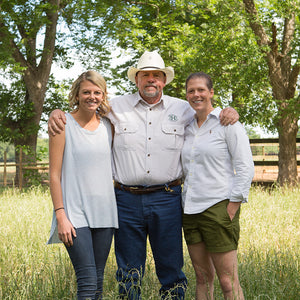This article is part of our first-ever EPIC Impact Journal. For more on this groundbreaking publication and how to get your hands on one, click here.
If you’re looking for Will Harris, head to the old Bluffton courthouse. You’ll find him there, cowboy hat in hand and his dog, Judge, by his side, working feverishly to keep White Oak Pastures churning away as it has since 1866. But he’s not just trying to sustain his family’s legacy — he’s fighting to secure its future.
 Will with his two daughters, Jenni and Jodi
Will with his two daughters, Jenni and Jodi
Will’s battle isn’t unique. Unfortunately, it’s one that almost every part of rural America is facing, especially in the South. As agriculture has morphed from a key part of every province’s local economy to mechanized, industrialized conglomerations ruled by ruthless efficiency, towns like Bluffton have been stripped of economic opportunity. With no means of employment available, locals are forced to move elsewhere in search of better lives, leaving behind barren wastelands of past glories.
Bluffton was never a huge place. Founded in 1814 by settlers moving westward, it’s not accessible through any large navigable waterway and sits in the shadow of the Appalachian Mountains. As a result, Will said that its population probably peaked at around 400 people in 1910. But with fertile soils and reliable conditions, it’s always been a damn good place to farm. “It’s a geological anomaly, really,” he said in his thick Georgia drawl. “Thanks to an unbelievable combination of geology and meteorology, it’s an extremely productive place for farming and agriculture. That’s why archaeological findings suggests it was once home to one of the largest cities north of Mexico between 300-600 AD.”

That natural abundance drew Will’s great-grandfather to the area in the mid-1800’s and has kept his family there since. But when modernized farming arose after World War II, traditional practices were swept away — and with them, economic and ecological balance. Regional agriculture and ranching were replaced by row crops, machines, and monoculture. The new order didn’t care about uniting local economies or drawing workers: it was focused only on mass yield by whatever means necessary. Like so many others at the time, the Harris family adjusted to these standards to survive.
By the mid-90’s, Big Ag was in full swing in Bluffton. The town was barely holding on. According to Will, things were so bad then that the post office was the only place around where you could buy something. The population had dwindled to the point where basic services like gas stations, restaurants, or grocery stores simply weren’t needed. White Oak was in business but centered solely on raising livestock; the farm was overrun by pesticides, chemicals, and natural imbalance. Will knew he had to make a change. “Since I was a little boy, all I’d ever wanted to do was run [White Oak]. But as the years passed, I liked our operation less and less,” he explained. “I felt like my childhood dream was slowly dying with every round of pesticides and hormones we introduced to the land and cattle.”

White Oak workers prep a sun-dried rawhide for production in their on-site workshop.
So Will decided to buck the system. There weren’t many available resources on alternative agriculture practices at the time, but Will had one reliable outlet: history. Looking to his great-grandfather’s tactics, which integrated multiple species of animals and crops to create a thriving ecosystem, he turned his one-sided operation on its head. He cut the chemicals out and introduced chickens, goats, pigs, and other animals back onto the farm. It was all part of the strategy behind holistic land management, which seeks to create ecological harmony to strengthen lands, improve their yield, and maximize animal quality.
Will’s move was revolutionary. It directly rejected the chemical-ridden, commoditized industry that agriculture had become and sought a more intimate appreciation of natural resources. It vowed to leave the world better than it found it. And it worked. In the 22 years since White Oak made the shift to holistic, they’ve become one of America’s leading producers of grass-fed beef, pastured-raised pork, and free-range chicken. This explosion of business and productivity has earned them nationwide acclaim and made them the industry leader in educating consumers and producers alike. But perhaps most importantly: it’s brought jobs back to Bluffton.
Over the last ten years, White Oak’s staff has grown from four employees to 140, exceeding the town’s population just a few decades ago. This influx of people increased the need for public services, businesses, and housing, so Will bought up a bunch of old, dilapidated buildings and opened a general store, restaurant, and employee housing. He even bought the old courthouse, which functions as his office. “You can tell by my pup’s name who’s really in charge,” he joked.

Bluffton’s economy hasn’t been this strong in a century. Fueled by White Oak’s commitment to providing fair wages — their average worker makes twice the county average — and operational growth, the town is doing the impossible: reviving its economy by going back to its roots. “This place has never had a factory or mill, and it’s not making a comeback through tourism or gentrification,” Will said. “Agriculture’s the girl that brought us to the party and saved this town.”
Will doesn’t fancy himself a miracle worker or Bluffton an isolated case. He believes other towns could make the same adjustment if their landholders commit to a holistic approach. “We never set out to revive this town. We can’t take credit for it or pretend this was part of some grand vision — it was just a byproduct of the plan,” he admitted. “What we’ve done here is certainly replicable. There’s no hidden formula or secret sauce: we simply changed the way we farmed and embraced a larger view of how we impact our resources and communities.”

Regardless of Will’s intentions, he’s stoked the flames of the food revolution far beyond Bluffton. White Oak Pastures has proven better land management creates a harmonious system that produces higher quality animals and generates products that consumers want to purchase. But, despite their growing notoriety and burgeoning local economy, Will acknowledges there will still be plenty to be done long after he’s gone. “We’re still figuring things out. If you’re going to make a truly meaningful impact, you’ve got to think generationally.”
Luckily, Will knows the Harrises aren’t leaving Bluffton anytime soon. His daughters Jenni and Jodi each gave birth to their first children earlier this year: Jack and Hattie.



